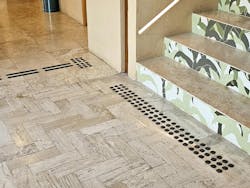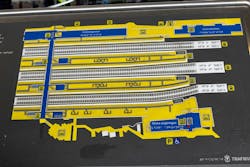Braille Signage and Tactile Elements: Essential Components in Public Space Design
Key takeaways:
- With about 15% of the global population living with disabilities, accessible design serves a substantial user base.
- Although Braille usage has declined due to the availability of digital assistive technologies, it remains critical for safety and navigation, especially where audio cues are not a viable option.
- Applying tactile surfaces in specific areas contributes to safety and wayfinding, defining spaces for the visually impaired.
Why we think this matters to design professionals: By understanding how to integrate tactile elements seamlessly into their designs, professionals can create spaces that are legally compliant and that promote independence and dignity for everyone.
Integrating Braille signage and tactile elements into public spaces has become increasingly important as the architecture and design industry prioritizes sustainability and inclusivity. These features enhance accessibility for individuals with visual impairments and contribute to creating navigable and welcoming environments for all occupants.
The Necessity of Inclusive Design
Globally, over 1 billion people live with some form of disability, representing approximately 15% of the world’s population. This includes many individuals with visual impairments who rely on various tools and technologies to navigate public life. These figures underscore the critical need for accessible design that serves a broad spectrum of physical, sensory, and cognitive needs.
Among people who are legally blind, the use of Braille has shifted considerably over the past several decades. While Braille once served as the primary literacy tool for blind individuals—with usage rates as high as 50% in the 1960s—that number has dropped significantly in recent years to 10%. This decline is partly due to the growing availability of audio-based and digital technologies, such as screen readers and smartphones, offering alternative information access methods.
Despite this shift, the 200-year-old tactile system remains vital. It continues to support millions of people worldwide in reading and writing, especially in environments where audio cues may be insufficient or unavailable.
The American Foundation for the Blind notes that Braille is used globally in many native languages, continuing to provide a means of literacy, independence, and engagement with the built environment. For this reason, incorporating Braille into public signage is more than a matter of accessibility—it also enables equitable participation in public life.
Implementing Braille Signage in Public Spaces
Incorporating Braille signage into public spaces is a practical step toward inclusivity. These signs assist individuals with visual impairments in navigating environments safely and independently.
Effective Braille signage includes room identifiers, directional signs, and informational plaques. These signs should be strategically placed at consistent heights and locations to ensure they are easily locatable. Additionally, combining Braille with raised lettering accommodates a wider range of visual impairments, enhancing the overall user experience.
The Role of Tactile Paving in Navigation
Tactile paving—also known as detectable warning surfaces—is critical in guiding individuals with visual impairments through public spaces. These textured ground surface indicators alert people to changes in the environment, such as pedestrian crossings, transit platforms, and building entrances.
Tactile pavers help improve city accessibility by guiding blind or low-vision pedestrians through obstacles, marking safe paths, and supporting navigation in crosswalks, transit platforms, and building interiors. Tactile paving comes in various forms, including warning surfaces with raised domes to indicate hazards and guidance surfaces with raised bars to direct movement. The implementation of these surfaces should be consistent and standardized to provide reliable cues for navigation.
Enhancing Safety Through Tactile Elements
Beyond navigation, tactile elements contribute significantly to the safety of public spaces. For instance, nonslip mats or adhesive strips can be applied to areas prone to moisture, such as restrooms and entryways, to add traction and prevent slips and falls. These features are particularly beneficial for individuals with mobility challenges.
Clear pathways are also essential. Ensuring that walkways are free of obstacles and that flooring transitions are smooth facilitates mobility for all users. Incorporating tactile cues, such as textured flooring at the top and bottom of staircases, can alert individuals with visual impairments to changes in elevation, reducing the risk of accidents.
Equally important is the consideration of reach and access in shared public settings. While exact requirements vary by context, industry guidance recommends counter heights between 32 and 36 inches to accommodate a range of mobility needs, including people using walkers, manual wheelchairs, or powered chairs. Ensuring surfaces like information desks, bathroom sinks, or service counters fall within this range enhances safety by minimizing overreaching or awkward maneuvering.
Integrating Tactile Features in Design
Design professionals can integrate tactile features into public spaces without compromising aesthetics. For example, maps can be provided in large facilities like malls and transit stations to assist with orientation and wayfinding. They should be designed with raised elements and Braille to convey spatial information effectively.
Incorporating tactile elements into flooring materials is another approach. Textured tiles or patterns can delineate pathways or highlight specific areas, aiding navigation. Additionally, using contrasting colors and materials can enhance the visibility of these features for individuals with low vision.
Advancing Universal Accessibility
Integrating Braille signage and tactile elements into public spaces is more than a compliance measure—it’s a commitment to creating environments that respect and accommodate the diverse needs of all individuals. By adopting these inclusive design practices, professionals contribute to a built environment that promotes independence, safety, and dignity for everyone.
As the architecture and design industry continues to evolve, prioritizing accessibility through the thoughtful integration of tactile features will be essential in advancing universal design principles. This approach benefits individuals with disabilities and enhances the overall experience for all occupants in built environments.
About the Author

Evelyn Long
Freelance writer
Evelyn Long is an experienced interior design writer that has been featured on the National Association of Realtors and DecorMatters sites. She specializes in improving workplaces for a diverse and modern workforce. She is also the editor-in-chief of Renovated Magazine, where she writes interior design advice for homeowners.




